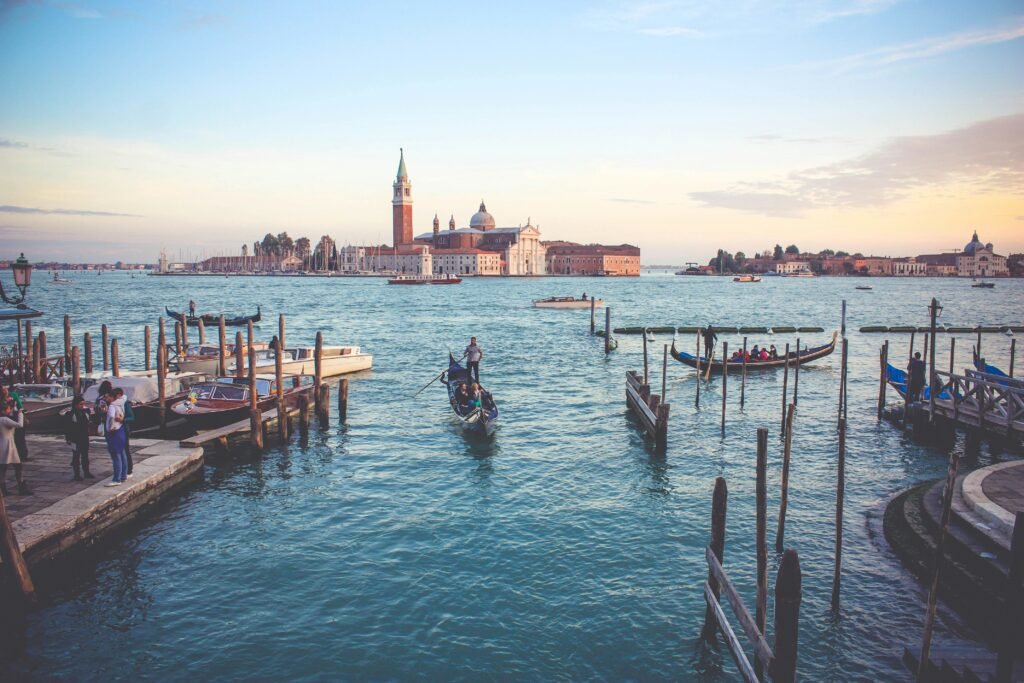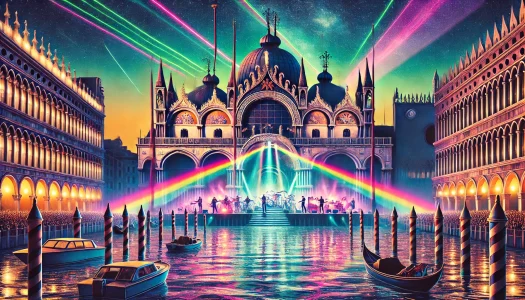On July 15, 1989, the timeless allure of Venice, Italy, collided with the sonic brilliance of Pink Floyd in what would become one of the most iconic concerts in rock history. As dusk fell over the ancient city, the band took to a floating stage anchored in the Venetian lagoon, performing against the backdrop of St. Mark’s Square and its historic, Gothic architecture. This unprecedented setting transformed the concert into more than just a musical event; it became a fusion of rock and Renaissance, where art, history, and sound converged in a spectacular display.
Background: The Road to Venice

The journey to Pink Floyd’s legendary Venice concert began with the launch of their “A Momentary Lapse of Reason” tour in 1987. This tour marked the band’s return to the stage after several years of hiatus and the departure of founding member Roger Waters. With David Gilmour, Nick Mason, and Richard Wright at the helm, the tour was a triumphant declaration that Pink Floyd remained a creative and musical force. Spanning over two years, the tour captivated audiences worldwide with its elaborate visual effects, innovative stage design, and the band’s iconic sound. By the time they arrived in Venice in the summer of 1989, Pink Floyd had solidified their status as pioneers of live rock performances.
The Venice concert was envisioned as the grand finale of the European leg of the tour. It was meant to be a celebration—a free concert broadcast live on television to millions of viewers around the world. However, the road to making this vision a reality was fraught with controversy and logistical hurdles. The idea of staging a massive rock concert on a floating platform in one of the world’s most delicate cities sparked fierce debate.
Venice, with its historic buildings and fragile infrastructure, was already struggling with the effects of tourism and environmental degradation. The prospect of hosting over 200,000 concertgoers on its ancient streets raised serious concerns among local authorities and preservationists. There were fears that the vibrations from the concert’s sound system could damage the city’s buildings, many of which were centuries old and built on unstable foundations. Moreover, the logistics of managing such a large crowd in a city with limited space and narrow streets posed significant challenges.
Critics argued that Venice was ill-suited for such a large-scale event, predicting chaos and potential harm to the city’s cultural heritage. The concert’s organizers, however, were determined to push forward, arguing that the event would bring global attention to Venice’s plight and generate much-needed revenue for the city. The debate reached a fever pitch in the weeks leading up to the concert, with some local officials even threatening to cancel the event.
In the end, a compromise was reached, allowing the concert to proceed but with strict regulations. The stage was constructed on barges moored in the lagoon, and sound levels were carefully monitored to minimize potential damage. Despite the intense controversy and logistical challenges, Pink Floyd remained committed to delivering an unforgettable performance, knowing that the Venice concert would be unlike anything they—or their fans—had ever experienced.
The Concert Experience: A Night on the Lagoon
As the sun dipped below the horizon on July 15, 1989, the city of Venice transformed into a stage for one of the most extraordinary concerts in rock history. The setting was nothing short of magical: a massive floating stage, anchored in the middle of the Venetian lagoon, with the grandeur of St. Mark’s Basilica and the Doge’s Palace providing a breathtaking backdrop. The stage itself was a feat of engineering, constructed on a series of barges that gently swayed with the lagoon’s waters. This unique setup, combined with the surrounding architecture, created a surreal contrast between the ancient and the modern, as Pink Floyd’s futuristic soundscapes echoed across the city’s centuries-old canals.
The anticipation in the air was palpable as the night began to fall. Thousands of fans, many arriving by boat, crowded the waterfront, while others packed the narrow streets and piazzas, vying for the best possible view of the spectacle. The mood was electric, a mix of excitement and wonder as the city, usually steeped in a quiet, almost ethereal calm, braced itself for an unprecedented night of music. The crowd, a blend of locals and international fans, buzzed with anticipation, knowing they were about to witness something truly historic.
As the first notes of “Shine On You Crazy Diamond” rang out, the stage erupted into a dazzling display of lights and lasers. The visual effects, meticulously choreographed to synchronize with the music, turned the night sky into a kaleidoscope of colors. The lighting rig, suspended over the stage, shot beams of light into the sky, creating a dynamic interplay between the ancient cityscape and the modern spectacle. The effect was mesmerizing, as if the very architecture of Venice was coming alive, pulsing in rhythm with the band’s iconic sound.
The sound quality, despite concerns about the open-air setup, was astonishing. Pink Floyd’s music, known for its rich, layered production, was delivered with pristine clarity across the lagoon. The waters of Venice acted as a natural amplifier, carrying the sound to every corner of the city. The band’s performance was as tight and powerful as ever, with David Gilmour’s soaring guitar solos and Richard Wright’s lush keyboard textures filling the night air. Each song was a carefully crafted experience, enhanced by the interplay of light, water, and sound that surrounded the audience.
The combination of the stunning visuals, the impeccable sound, and the sheer audacity of staging a rock concert in such an iconic location made the night unforgettable. As the concert reached its climax with “Comfortably Numb,” the Venetian skyline was bathed in a sea of light, reflecting off the lagoon in a symphony of colors. The atmosphere was one of pure euphoria, with the crowd fully immersed in the spectacle unfolding before them. It was a night where the boundaries between music, art, and history blurred, leaving an indelible mark on everyone fortunate enough to be there.
Setlist and Performance
Pink Floyd’s Venice concert on July 15, 1989, was a masterclass in live performance, showcasing a carefully curated setlist that spanned the band’s illustrious career. Opening with the ethereal strains of “Shine On You Crazy Diamond,” the band immediately set the tone for the evening, blending atmospheric soundscapes with the visual splendor of the Venetian night. This iconic track, a tribute to their former bandmate Syd Barrett, resonated deeply with the crowd, its haunting melodies amplified by the surreal setting. As the song unfolded, the stage’s lights danced across the lagoon, creating an otherworldly ambiance that captivated the audience from the first note.
The setlist continued to deliver one classic after another, weaving through the band’s expansive catalog. “Learning to Fly” and “Sorrow,” both from the A Momentary Lapse of Reason album, were standout moments, with David Gilmour’s soaring guitar work cutting through the night air. The band’s performance of “Wish You Were Here” was particularly poignant, with its introspective lyrics taking on a new dimension against the historical backdrop of Venice. The crowd, many of whom had traveled from far and wide, sang along in unison, their voices echoing across the city’s canals.
“Time” and “Money” from The Dark Side of the Moon brought a surge of energy to the performance, their rhythmic complexity and lyrical depth underscoring the band’s musical prowess. Each member of Pink Floyd was in top form, delivering performances that were both technically flawless and emotionally charged. Nick Mason’s drumming provided a solid backbone to the set, while Richard Wright’s keyboard work added lush layers to the sound. Gilmour’s guitar solos, in particular, were nothing short of transcendent, his fingers dancing effortlessly across the fretboard, drawing every ounce of emotion from his instrument.
The concert reached its zenith with “Comfortably Numb,” arguably one of the most anticipated songs of the night. Gilmour’s legendary guitar solo, set against the dramatic backdrop of Venice illuminated by a sea of lights, was a moment of pure magic. The solo’s soaring notes seemed to hang in the air, resonating with a power that left the crowd spellbound. The audience’s reaction was overwhelming; waves of applause and cheers echoed across the lagoon as fans were swept up in the intensity of the performance.
Throughout the night, the band’s interaction with the audience was subtle but impactful. Pink Floyd has always been known for letting their music and visuals take center stage, and this concert was no exception. Yet, there were moments of connection that transcended the distance between the floating stage and the crowd. The band’s dedication to delivering a flawless performance, coupled with their respect for the unique setting, created an intimate atmosphere despite the vast scale of the event.
The Enduring Legacy
Pink Floyd’s Venice concert on July 15, 1989, stands as a defining moment in both the band’s history and the broader narrative of live rock performances. Against the breathtaking backdrop of one of the world’s most iconic cities, Pink Floyd delivered a show that was as much a visual and architectural spectacle as it was a musical triumph. The floating stage, the interplay of light and sound, and the atmospheric setting created an unforgettable experience that transcended the traditional boundaries of a rock concert.
Throughout the evening, the band seamlessly wove together a setlist that highlighted their most iconic work, from the reflective melancholy of “Wish You Were Here” to the explosive energy of “Comfortably Numb.” Their performance, marked by technical brilliance and emotional depth, resonated powerfully with the audience, who responded with an outpouring of enthusiasm and awe. The concert’s audacity—staging a rock show on water in a city as historic and delicate as Venice—only added to its legend, as did the controversies and logistical challenges that surrounded it.
In the years since that remarkable night, the Venice concert has come to symbolize the height of Pink Floyd’s live performance capabilities. It was a moment where music, history, and technology converged, creating a unique event that could never be replicated. The concert’s enduring legacy lies not just in the memories of those who were there but in its influence on the future of live music production. It showcased what was possible when ambition and artistry were pushed to their limits, leaving an indelible mark on the cultural landscape.
